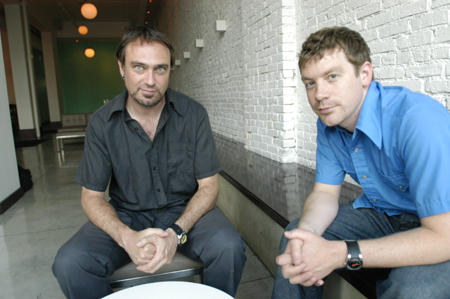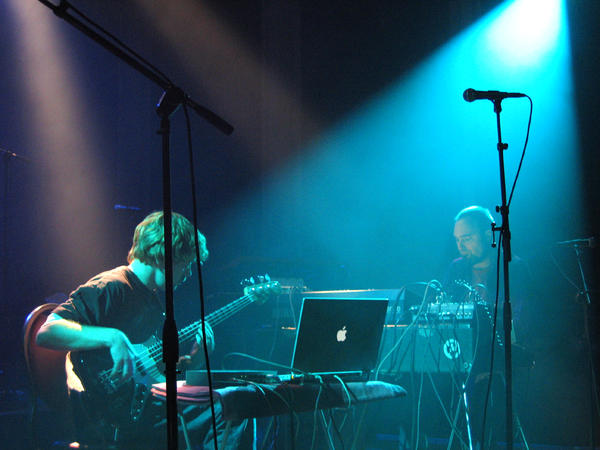Mix Tape: Keston and Westdal: Like Little Lego Bricks
Rich Horton spoke to John Keston and Nils Westdal, of the eponymous jazz group, about their fresh approach to recording technology.


With the advent of computerized multi-tracking, looping software and digital recording, it became easier for many non-musicians to make music. It also made it easier for people to use the same drum loops and sounds, and be unoriginal.
John Keston and Nils Westdal (who make up the group Keston and Westdal) have used the new technology not to substitute for talent but to augment their music skills, creating a unique mix of electronic jazz and real-instrument-driven electronic compositions. They never use canned loops or sounds; they create their own, which help keeps their sound their own.
Keston and Westdal are accomplished musicians. Keston has played his Rhodes piano with live local hip-hop groups. He’s done club music and enjoyed a ten-year solo piano gig. He also has a degree in music technology from Metropolitan State University. Westdal groomed his chops with many local groups and musicians, and studied at the Berklee School of Music in Boston with a scholarship.
While neither of them were born here, both have them have been living and playing in Minnesota for over 20 years. They consider themselves Minnesotan through and through. Westdal even admits he went ice fishing once. He found it was a good excuse to get drunk and really cold.
Their writing process has changed over the years and since their main focus had been playing in live bands, when they started out in 2000, they wanted to do something together but didn’t really have a plan for it. What came together was their first album Super Structure Baby.
“When we started doing this, we thought, let’s get out of the band thing and try producing a record and not worry about performing or anything. In fact, for the first record [Super Structure Baby], we were like, we are never going to play this stuff live after we made it all. It was all in the studio, you get a rough idea, we start cutting it apart within the software and pasting things together like little Lego bricks,” said Keston.
Westdal noted, “The beauty of that first record is also we didn’t know we were making a record. It was more like let’s get together and bounce some ideas off each other. We just started recording sounds and started laying bass lines over some really basic loops that we didn’t make then, we weren’t programming back then, we didn’t have those chops back then. After maybe two songs, we went, hey these kind of glow.”
From the time they recorded the first album, they were able to hone their computer skills as software updates came and went. After using programs like Cakewalk and Sonar they found the computer program Ableton Live, which enabled them to find a system of working together on two separate laptops simultaneously.
Their new album, Truth Is Stranger, mixes different types of beats, all with a jazzy and hip-hop inflection with real tight bass lines and Rhodes organ wandering around the electronic beat. Many of the songs are instrumental, but guest vocalists like Desdamona make an appearance. With the mix of styles and mixture of electronic music and analog instruments, it would be hard to give it to one genre. Keston and Westdal have figured out a label for their music, and it makes perfect sense.
Westdal explains: “We came up with the term O.E.M. or Organic Electronic Music. This term I.D.M. that people used to describe us sometimes–which I don’t really like the meaning of it–is supposed to be Intelligent Dance Music. It just seems a bit presumptuous to call your music that. ‘My music is intelligent, is your music intelligent? I don’t know, mine is named intelligent.’ I didn’t want our music to be labeled as that. The organic element is the fact we are using our instruments. He is playing an actual string instrument; I am playing a Rhodes electric piano which is electro mechanical. Those are real analog instruments, so we are getting that organic sound. Along with the electronics, so Organic Electronic is what we came up with to explain it”
Somewhere between the first album and when the technology caught up with them, they were able to translate these recordings into a live show. So as not to be tied down to the technology, they often let things run free form inside their compositions and are able to improvise on stage to keep themselves and the audience interested. They also employ a live drummer once in awhile, which to us amateur musicians might seem hard to do.
“The drummers that we use are rock stars and they never need to rehearse, so they say. The way we are performing live, John and I have so much free structure, we have these little building blocks that come together. These compositions that we have are different every time, they’re improvisations within themselves. When we get a drummer up there who’s good enough we can just say, let’s turn on the drummer and he just goes. We send him a click into his headphones,” said Westdal .
Keston fills in: “He is also listening to what we are doing. What’s nice is with the way we have everything set up, to have a live drummer we don’t have to play everything that is normally part of that composition. We’ll just use the parts that don’t interfere with live drums. We’ll take out all of the stuff that was heavier beats and leave that up to a live drummer. The nice thing about it, is it is super easy to do without having to create brand new documents, we can just mute those parts and unmute them when we don’t have a live drummer.”
Their first two albums took years to complete; and the styles of the songs were more mixed because they were made over such a long time.. Their third album, which is pretty much done and only took about a year to complete, ended up sounding more cohesive. They hope to release it early next year. They also have put together a record label, to make it easier to get their albums out on their own terms.
“We are going to go and do what we want; no one is going to say things like we’d like it if you had more vocal tracks on your record. One of the things that has been real frustrating for us, we are really an instrumental group, it’s what we do. And instrumental music doesn’t always get respect but it’s a valid kind of music, it’s been around as long as any other kind of music ,” said Keston.
Westdal adds, “There have been so many booking agents that have said to us, we would love to have you on, everything, but hiring a singer and some back-up vocals. No, that’s not what we do. That is really frustrating.”
While the corporate music industry is having a hard time with the new future of music, digital downloads, and their inability to find artists to create anything interesting, Keston and Westdal might have found a style of music that fits into its own niche. Organic Electronic Music pulls together two different worlds and while some people in the industry might not quite get it yet, Keston and Westdal will continue creating interesting music ahead of their time until everything catches up with them.